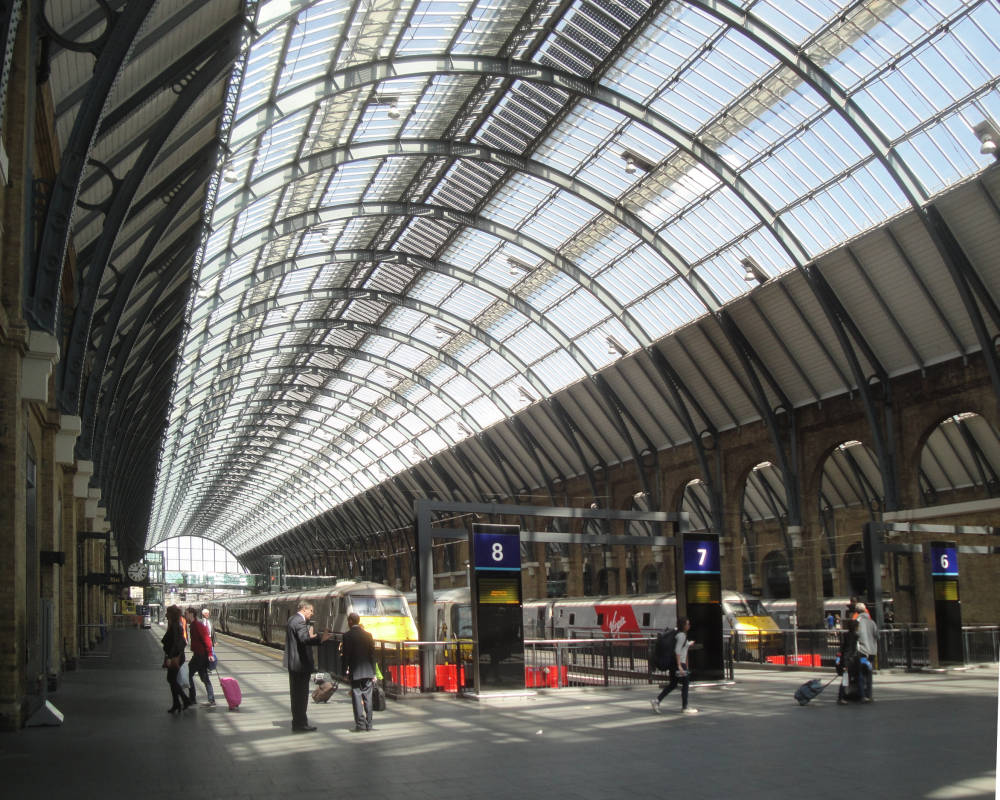The head-type station plan, in which all passengers entered and left through the head-building across the end of the lines, proved to be the most long- lived scheme for terminals. Numerically important even in the experimental period, they were of continuing significance. A single building was erected across the ends of the tracks with platforms lying between the tracks and perpendicular to the building. This was the plan of the Brighton Station by David Mocatta, 1840-41. At York in 1840-41 a "U" or "stirrup" plan was employed with wings extending back from the head building to surround the end of the spur tracks on three sides. Other variations occurred, even in large stations: "L's," for example, and a "T" plan at Stuttgart in 1863-68, where the returned wing lies between two sets of spur tracks.
Two British stations . . . made the shed the dominant feature. The first was the Liverpool Central Station built by the engineer John Fowler in 1874, and the second was the Manchester Joint Central Station, begun two years later. Both sheds were arched, and without visible ties. They are striking examples of refined technology. The profiles are reversed catenaries in shape, exceedingly subtle and worthy of their prominent role on the exterior. The high sheds reduce the wings and marquees to inconsequence, thereby reminding us of the earlier Fenchurch Street Station in London and of the numerous American arched train-barns. Coming so long after the Crystal Palace, they can hardly be considered an example of its influence, though they represent the lesson which might have been learned from it. — Carol Meeks, pp, 33, 86.
Mixing Iron and Stone

- Introduction: A Selection of Great Victorian Railway Stations
- The Crown Street station of Liverpool and Manchester Railway, 1830
- Wylam Station, Northumberland, 1835
- Doric Arch, Euston Station, London and Birmingham Railway, 1839
- Railway Station, Brighton, 1841
- Great Joint Station of the Croydon, Brighton, and Dover Railway Company, Southwark, 1843
- Railway Station, Bradford-on-Avon, 1848
- Needham-Market Station on the Norwich and Ipswitch Railway, 1849
- Windsor & Eton Riverside Station, Datchet Road, Windsor, 1849
- Lime Street Station, Liverpool, 1849
- King's Cross Station, Great Northern Railway, 1852
- Central Station, Newcastle, 1853 — "the first covered station in the world"
- The Great Western Railway Terminus, at Paddington, 1854
- Crystal Palace Station, London, 1854
- Platforms, Durham, 1857
- The Metropolitan Railway, London, 1862
- The Ludgate Hill Station of the London, Chatham, and Dover Railway, 1865
- The High-Level Station at the Crystal Palace, 1865
- Cannon-street Station, South-Eastern Railway, 1866
- Trainshed beams, St, Pancras, London, 1868-77
- St. Pancras, London (sitemap : two dozen photographs), 1868-77
- The Juxtaposition of Engineering and Architectural Elements in the Trainshed, St. Pancras, London, 1868-77
- Station wall with beams supporting the train shed, St. Pancras, London, 1868-77
- Kew Gardens Station, 1868-70
- Waterloo Station interior, 1869, 1878, 1885; rebuilt between 1900 and 1922
- Liverpool Street Station, 1874
- Derby Gothic on the Settle-Carlisle Railway, 1876
- South Kensington Station, Metropolitan and District Railways, London
- Tynemouth Station, 1882
- Liverpool Street Station, London, 1884
- Norwich Station, 1886
- Sheringham Station, Norfolk, 1887
- Eastbourne Station, Sussex, 1886
- High Street Kensington Station, Metropolitan and District Railways, London
- Lancaster Station: iron beams, glass panels and stone supports
- Suburban Station on the South Eastern Railway, 1885
- Llandudno Railway Station, North Wales, 1892
- Windsor & Eton Central Station, George Road, Windsor, 1897
- The Marylebone Street Station (Great Central Railway), London, 1899
- Former Metropolitan Railway entrance (near Liverpool Street Station)
- The Midland Railway Station, Sheffield (1905 with elements from 1870)
- Barons Court Station on the District Line (formerly District Railway), London, 1905.
- Victoria Station, eastern side (the former London, Chatham and Dover Railway Station frontage), c. 1908-1910
- Port Erin, Isle of Man Railway
- Huddersfield Station, West Yorkshire, 1850
- (Former) Pocklington Station, Yorkshire
- First stone station, York, 1841
- Old station outbuildings, York
- York Station, 1877
- Trainshed at York Station, 1877


Stations in Former British Colonies
For Comparison: European Railway Stations
- Gare d'Orsay, Paris (now converted to the Musée d'Orsay)
- Central Station, Porto, Portugal [will open in new window]
- SNCF Station in Roubaix (Greater Lille area)
- SNCF Station, Lille Flanders
- Gare de Rouen-Rive-Droite, Rouen, France
- Eliel Saarinen's Central Station, Helsinki, Finland
- Central Station, Amsterdam, the Netherlands

Related Material
Bibliography
Crook, J. Mordaunt. The Dilemma of Style: Architectural Ideas from the Picturesque to the Post-Modern. Chicago: University of Chicago Press, 1987.
Meeks, Carol L. V. The Victorian Railroad Station: An Architectural History. New Haven: Yale UP, 1956.
Minnis, John. Britain’s Lost Railways: The Twentieth-Century Destruction of Our Finest Railway Architecture. London: Aurum Press, 2014.
Last modified April 17, 2019